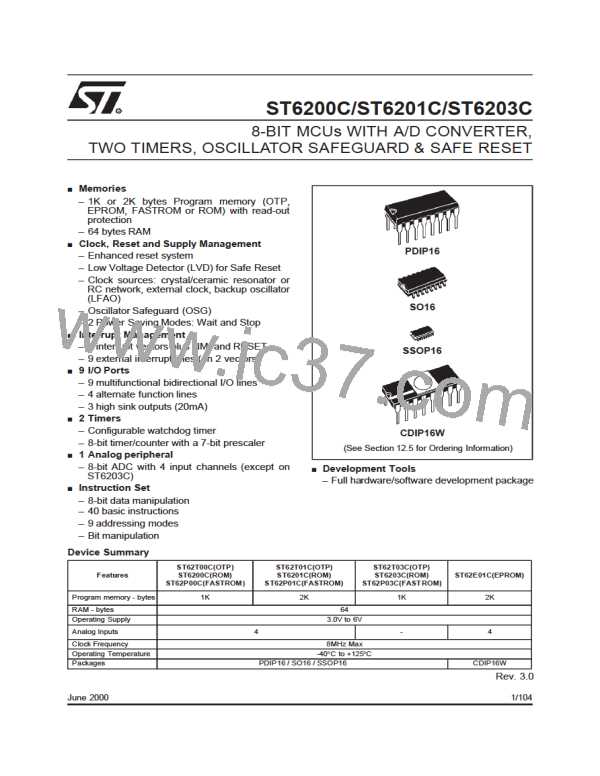ST6200C/ST6201C/ST6203C
CLOCK SYSTEM (Cont’d)
5.1.2 Oscillator Safeguard (OSG)
imum internal clock frequency, f , is limited to
INT
OSG
f
, which is supply voltage dependent.
The Oscillator Safeguard (OSG) feature is a
means of dramatically improving the operational
integrity of the MCU. It is available when the OSG
ENABLED option is selected in the option byte (re-
fer to the Option Bytes section of this document).
5.1.2.2 Management of Supply Voltage
Variations
Over-frequency, at a given power supply level, is
seen by the OSG as spikes; it therefore filters out
some cycles in order that the internal clock fre-
quency of the device is kept within the range the
The OSG acts as a filter whose cross-over fre-
quency is device dependent and provides three
basic functions:
particular device can stand (depending on V ),
DD
and below f
cy with OSG enabled.
: the maximum authorised frequen-
OSG
– Filtering spikes on the oscillator lines which
would result in driving the CPU at excessive fre-
quencies
5.1.2.3 LFAO Management
– Management of the Low Frequency Auxiliary
Oscillator (LFAO), (useable as low cost internal
clock source, backup clock in case of main oscil-
lator failure or for low power consumption)
When the OSG is enabled, the Low Frequency
Auxiliary Oscillator can be used (see Section
5.1.3).
– Automaticallylimiting the f
a function of supply voltage, to ensure correct
operation even if the power supply drops.
clock frequency as
Note: The OSG should be used wherever possible
as it provides maximum security for the applica-
tion. It should be noted however, that it can in-
crease power consumption and reduce the maxi-
INT
5.1.2.1 Spike Filtering
mum operating frequency to f
Characteristics section).
(see Electrical
OSG
Spikes on the oscillator lines result in an effectively
increased internal clock frequency. In the absence
of an OSG circuit, this may lead to an over fre-
quency for a given power supply voltage. The
OSG filters out such spikes (as illustrated in Figure
10). In all cases, when the OSG is active, the max-
Caution: Care has to be taken when using the
OSG, as the internal frequency is defined between
a minimum and a maximum value and may vary
depending on both V and temperature. For pre-
DD
cise timing measurements, it is not recommended
to use the OSG.
Figure 10. OSG Filtering Function
f
f
f
f
OSC< OSG
OSC> OSG
f
f
OSC
OSG
f
INT
Figure 11. LFAO Oscillator Function
MAIN OSCILLATOR
STOPS
MAIN OSCILLATOR
RESTARTS
f
f
OSC
LFAO
f
INT
INTERNAL CLOCK DRIVEN BY LFAO
20/104
1

 ETC [ ETC ]
ETC [ ETC ]